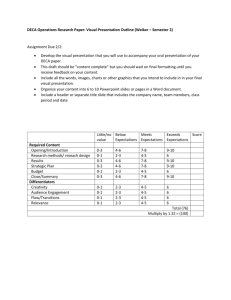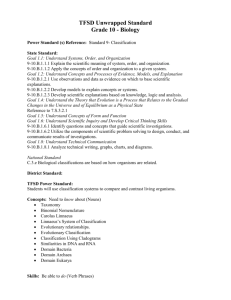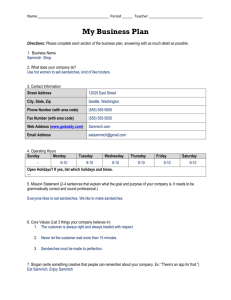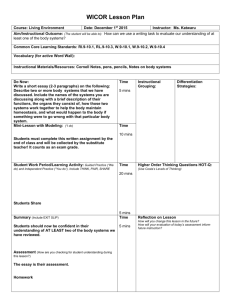English 9CP Midterm Exam FAQs (Frequently Asked Questions)
advertisement
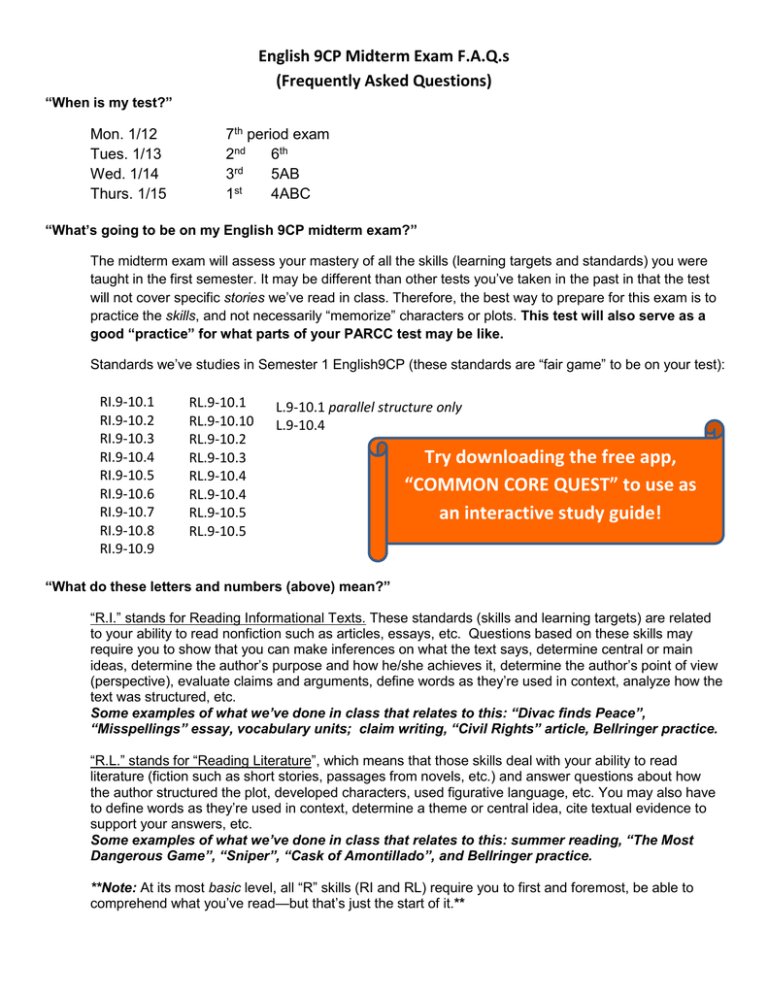
English 9CP Midterm Exam F.A.Q.s (Frequently Asked Questions) “When is my test?” Mon. 1/12 Tues. 1/13 Wed. 1/14 Thurs. 1/15 7th period exam 2nd 6th 3rd 5AB st 1 4ABC “What’s going to be on my English 9CP midterm exam?” The midterm exam will assess your mastery of all the skills (learning targets and standards) you were taught in the first semester. It may be different than other tests you’ve taken in the past in that the test will not cover specific stories we’ve read in class. Therefore, the best way to prepare for this exam is to practice the skills, and not necessarily “memorize” characters or plots. This test will also serve as a good “practice” for what parts of your PARCC test may be like. Standards we’ve studies in Semester 1 English9CP (these standards are “fair game” to be on your test): RI.9-10.1 RI.9-10.2 RI.9-10.3 RI.9-10.4 RI.9-10.5 RI.9-10.6 RI.9-10.7 RI.9-10.8 RI.9-10.9 RL.9-10.1 RL.9-10.10 RL.9-10.2 RL.9-10.3 RL.9-10.4 RL.9-10.4 RL.9-10.5 RL.9-10.5 L.9-10.1 parallel structure only L.9-10.4 Try downloading the free app, “COMMON CORE QUEST” to use as an interactive study guide! “What do these letters and numbers (above) mean?” “R.I.” stands for Reading Informational Texts. These standards (skills and learning targets) are related to your ability to read nonfiction such as articles, essays, etc. Questions based on these skills may require you to show that you can make inferences on what the text says, determine central or main ideas, determine the author’s purpose and how he/she achieves it, determine the author’s point of view (perspective), evaluate claims and arguments, define words as they’re used in context, analyze how the text was structured, etc. Some examples of what we’ve done in class that relates to this: “Divac finds Peace”, “Misspellings” essay, vocabulary units; claim writing, “Civil Rights” article, Bellringer practice. “R.L.” stands for “Reading Literature”, which means that those skills deal with your ability to read literature (fiction such as short stories, passages from novels, etc.) and answer questions about how the author structured the plot, developed characters, used figurative language, etc. You may also have to define words as they’re used in context, determine a theme or central idea, cite textual evidence to support your answers, etc. Some examples of what we’ve done in class that relates to this: summer reading, “The Most Dangerous Game”, “Sniper”, “Cask of Amontillado”, and Bellringer practice. **Note: At its most basic level, all “R” skills (RI and RL) require you to first and foremost, be able to comprehend what you’ve read—but that’s just the start of it.** “L” skills refer to “Language”, which include things like using parallel structure correctly, and determining the part of speech of words that are used, and/or clarifying the meaning of unknown words by using context clues and applying knowledge of familiar roots, prefixes and suffixes. Some examples of what we’ve done in class that relates to this: any/all writing assignments; vocabulary units, including our study of Root words (Unit 1-4), and Bellringer practice. “W” skills refer to “Writing”, which include things like supporting claims with reasoning and evidence; writing narratives with effective technique, well-chosen details, well-structured event sequences; writing clearly appropriate to task, purpose and audience; planning, revising and editing writing for specific purposes; using technology to benefit writing, draw evidence from reading to support your analysis through writing; etc. Some examples of what we’ve done in class that relates to this: Personal Narrative, timed narrative tasks, claim writing, and Bellringer practice. “How can I study for this test?” I strongly recommend that you take advantage of some outside resources and tools that are available to you that would allow you to study the STANDARDS (skills) you will need to show mastery of, on your test. That means, those of you who get a lot of flak for being/using your phones all the time might actually be able to say, “I’m studying!” and mean it. If you’re able to download a (free) app on your phone called Common Core Quest, I think you’ll find that extremely helpful. Simply choose your grade level (9), select the subject (Language Arts), then click on individual standards (skills, and learning targets) we’ve studied in first semester—see list on page 1. Then, practice answering quiz questions that assess your mastery of those standards. You can check your answers and find out immediately if you answered them correctly or not. If you’re told that you “need work”, then you can immediately (re)study those skills by reading or watching mini lessons on your phone, and then retake the quiz when you’re ready. More than half of your exam questions are based on some form of reading passage—either a short story, a passage from an article, a graphic or chart, etc. These reading passages will be provided for you, and will likely NOT be something that we read together in class before. Because you’ll need ample time to read carefully and critically, the majority of the 100 minutes you’re given for the exam period will likely be needed for you to read. Therefore, the more practice reading and answering questions you have prior to the test, the better. “How many, and what kind of questions will be on the test?” The questions themselves will be matching, multiple choice, or fill-in (choose from the possible answers). As mentioned previously, most of these questions will be based on a text that you’ll have to read first. There will be approximately 55 questions on the midterm exam. “How many “points” is it worth?” Your semester exam (midterm) is worth 20% of your first semester grade. Your overall first semester grade is an accumulation of your quarter 1 and quarter 2 grade, combined with your midterm exam grade. A mathematical “formula” that you can use to determine your overall semester (and yearly grade) can be found below: “Formula” Q1 percentage number x2 + Q2 percentage number x2 + midterm percentage number x1 = “X” “X” divided by 5 = your Semester 1 percentage grade Example: Q1 (83x2) + Q2 (87x2) + Midterm (73x1) = 164 + 174 + 73 = 411 411/5 = 82.2 Final semester 1 grade = 82% (B) Example skill-based questions for each standard/skill that may appear on the English 9CP Midterm: L.9-10.1 “Which of the following sentences does not use parallel structure?” L.9-10.4 “What does the root “dic” or “dict” mean, based on the following examples? The palace issued an edict forbidding the rebel prince from entering the country. When asked to defend his argument, Luther cited a dictum of his favorite poet. The jury indicted Richard on seven counts of burglary. RI.9-10.1 “Which of the following statements is stated directly in the text?” RI.9-10.2 “Which of the following is the most accurate objective summary of the text?” RI.9-10.3 “In his speech, the president structures his argument by…” Answer: proposing a general vision for the future and then giving specific examples to back it up. RI.9-10.4 “Which definition of gale is Patrick Henry using in the context above?” RI.9-10.5 “In the final two paragraphs of the text, the author strengthens his argument against alcohol by comparing the banning of alcohol to…” RI.9-10.6 “Which of the following accurately describes the author’s opinion of the Prohibition Laws?” RI.9-10.7 “In what way do the two news articles covering the Arizona immigration law differ?” RI.9-10.8 “Which sentence taken from the previous passage serves as the author’s most supported claim?” RI.9-10.9 “After reading the two speeches, “Second Inaugural Address” and “Gettysburg Address”, they differ with regard to…” RL.9-10.1 “Which of the following details supports the main idea you identified in the previous question?” RL.9-10.2 “Which of the following lines from the passage best express its main idea?” RL.9-10.3 “Which of the following sentences uses indirect characterization to show that Terra is funny?” RL.9-10.4 “One way to say “I can’t speak” by using an idiom and personification involving a cat would be to say which of the following?” RL.9-10.5 “Which of the following things most likely happens in the falling action of the story (passage provided)” RL.9-10.10 “The phrase “the sun had left his footprints in the sky” uses which of the following literary devices?” Roots we’ve studied in 1st Semester that are considered “fair game” to be on the Midterm Exam: Unit 1 Phot/phos (light) Luc (light) Spec/spect (to look at) Vid/vis (to see, look) Unit 2 nunc/nounc (to announce) voc/vok (to call) fa (to speak) dic/dict (to say, tell) Unit 3 hib/hab (to have, hold) fus/found (to pour out) ten/tain/tin (to hold) ple (to fill) Unit 4 form (to form, establish) apt/ept (to fit) pos/pon (to put, place) fig (to shape) Some of the “Basic” English Terms you should know to be able to apply that knowledge to the test questions: Parts of speech – know what they are, and be able to identify when a word is being used as an adjective, verb, etc. in a sentence. 1. 2. 3. 4. 5. 6. 7. 8. Noun – person, place, thing, or idea. (car, Sarah, happiness) Pronoun- a word that replaces the name of a noun (he, she, it, they,) Adjective- a word that describes a noun or Verb- a word that describes an Adverb- a word that describes a verb, an adjective, or another adverb (answers the questions, when? Where? How much? Why?) (example: happily, very, so) Preposition- shows the relationship of a noun or a pronoun to some other word (on, above, below) Article- (a, an, the) Conjunction- joins words or groups of words (and, but, because) Figurative Language and sound devices 1. Irony - Dramatic… when the reader or audience knows something a character does not a. Situational… when there is a disparity between what is expected and what actually occurs b. Verbal… when the speaker says one thing but means the opposite 2. Metaphor – an implied comparison between dissimilar objects: “Her talent blossomed” 3. Onomatopoeia – use of a word whose sound imitates its meaning: “hiss” 4. Oxymoron – phrase that consists of two words that are contradictory: “living dead” or “Microsoft works” 5. Personification – figure of speech in which non- human things are given human characteristics 6. Simile – a direct comparison of dissimilar objects, usually using like or as: “I wandered lonely as a cloud” 7. Hyperbole – extreme exaggeration to add meaning 8. Alliteration – repetition of the initial consonant sounds of words: “Peter Piper picked a peck of pickled peppers” 9. Assonance – repetition of vowel sounds followed by different consonant sounds: “Anna’s apples,” “the pond is long gone” 10. Figurative Language –language that represents one thing in terms of something dissimilar (non-literal language). Includes simile, metaphor, personification, hyperbole, symbol) 11. Imagery – language that appeals to the five senses 12. Symbol/symbolism – one thing (object, person, place) used to represent something else Plot Diagram and Story Terms 1. Exposition- The essential background information at the beginning of a literary work 2. Conflict - struggle between two or more opposing forces (person vs. person; nature; society; self; fate/God. 3. Rising action- the development of conflict and complications in a literary work 4. Climax- the turning point in a literary work 5. Falling action- results or effects of the climax of a literary work 6. Resolution - end of a literary work when loose ends are tied up and questions are answered 7. Dialogue - direct speech between characters in a literary work 8. Flashback- the method of returning to an earlier point in time for the purpose of making the present clearer 9. Foreshadowing- hint of what is to come in a literary work 10. Plot- The sequence of events in a literary work 11. Setting- The time and place of a literary work 12. Suspense – technique that keeps the reader guessing what will happen next 13. Theme – the underlying main idea of a literary work. Theme differs from the subject of a literary work in that it involves a statement or opinion about the subject. Dealing with characters… 14. Antagonist- character that is the source of conflict in a literary work 15. Characterization- The manner in which an author develops characters and their personalities 16. Point of view- the perspective from which a literary work is told… a. 1st person point of view- the narrator is a character in the story (use of ‘I’) b. 3rd person point of view- the narrator is outside of the story (use of ‘he’ ‘she’ ‘they’) 17. Stereotype- standardized, conventional ideas about characters, plots and settings 18. Protagonist- the main character in a literary work Dealing with the writing of the text… 19. Purpose—the reason the author is writing (or the speaker is speaking) a. To narrate b. To explain c. To argue 20. Mode—the way that an author (or speaker) meets his purpose/what he “says” a. Narration b. Explanation c. Argumentation i. Persuasion 21. Tone – the author’s attitude toward the subject of a work. Roots we’ve studied in 1st Semester that are considered “fair game” to be on the Midterm Exam: Unit 1 Phot/phos (light) Luc (light) Spec/spect (to look at) Vid/vis (to see, look) Unit 2 nunc/nounc (to announce) voc/vok (to call) fa (to speak) dic/dict (to say, tell) Unit 3 hib/hab (to have, hold) fus/found (to pour out) ten/tain/tin (to hold) ple (to fill) Unit 4 form (to form, establish) apt/ept (to fit) pos/pon (to put, place) fig (to shape)

